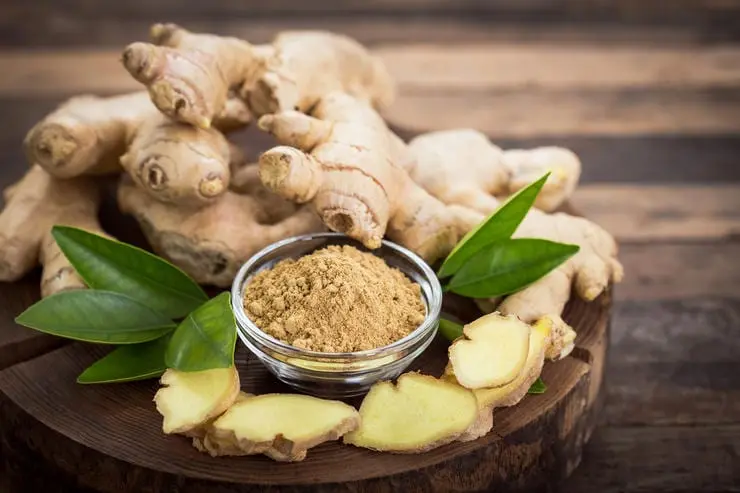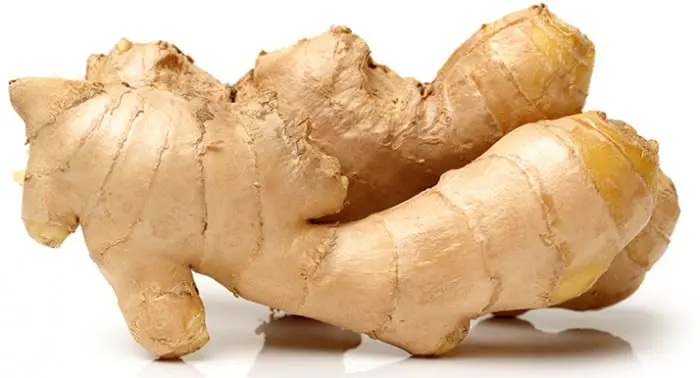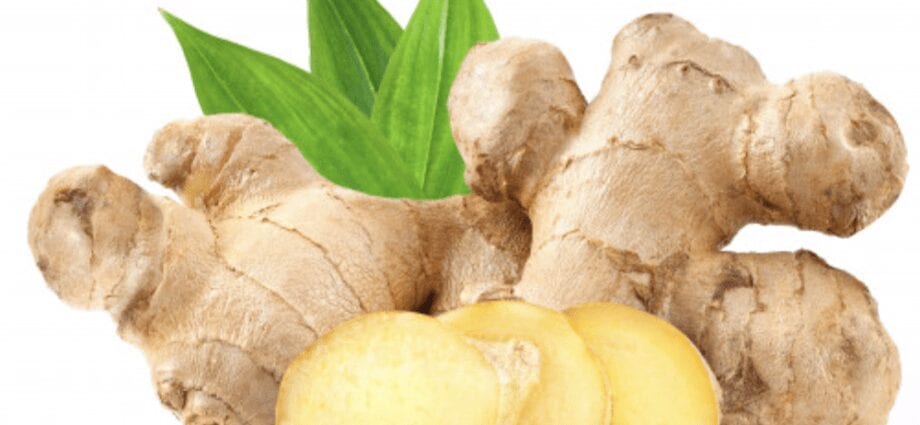Contents
Description
Ginger is known not only as a popular herb, but also as an excellent remedy for nausea, colds and other illnesses.
Ginger is a genus of perennial herbaceous plants from the ginger family. Its homeland is Western India and Southeast Asia. It does not grow in the wild in nature. Ginger is cultivated in the subtropics and tropics of Japan, China, West Africa, Brazil, India, Argentina, and Jamaica. Because of its beneficial properties, ginger can be grown as a garden or indoor plant.
Ginger has erect, reed-like stems, the length of which reaches one and a half meters. The roots look like fleshy roundish pieces of yellow or gray color. There is a black variety of ginger. Let’s take a closer look at the beneficial properties of ginger.
The history of ginger

Ginger was known in ancient times, but then its supply declined – and people began to forget about it. Now the popularity of ginger has increased, it is known mainly as a traditional pickled addition to Japanese cuisine.
Southeast Asia is considered the homeland of ginger, its properties have been known to man for more than 5 thousand years. Now the plant is cultivated in India, China, Australia and other countries; ginger is almost never found in the wild.
Ginger was not only eaten, but also used as a currency, since it was very expensive. Usually they eat only the root in dried, fresh, pickled form. Gradually, the medicinal properties of ginger were noticed, they began to study and prescribe it to patients with food poisoning and infections. Ginger helped to overcome the consequences of the lavish feasts of noble people.
This root vegetable is also quite famous as an aphrodisiac – it is even mentioned in Arabian tales as a means to “kindle passion”. And in China, the name of the plant is translated as “masculinity.”
Composition and calorie content
Ginger contains many useful substances, thanks to which, ginger is used not only as a spice, but also as a remedy. Ginger root contains vitamins (vitamin C, B1, B2), minerals: aluminum, potassium, calcium, iron, manganese, chromium, phosphorus, germanium; Caprylic, nicotinic and linoleic acids.
- Caloric content per 100 grams 80 kcal
- Proteins 1.82
- Fat 0.75 mg
- Carbohydrates 1.7 mg
Ginger flavor
The burning taste of ginger root is given by a phenol-like substance – gingerol. And the tart aroma of ginger root comes from the essential oil it contains. The beneficial properties of ginger can be supplemented with herbs such as chamomile, mint, lingonberry leaves, lemon balm. Ginger is not harmful to health, even if consumed in large quantities.
The benefits of ginger

Ginger contains vitamins, minerals and essential oils. One of the most famous properties of ginger is to help with food poisoning, nausea and vomiting. Due to the high content of magnesium, the elimination of toxins from the body is accelerated, and the state of the nervous system also improves. Pectins and fiber also stimulate peristalsis and active secretion of digestive juices, which reduces gas production and speeds up metabolism.
Ginger is useful for thickening the blood, as it dilutes it and improves circulation in the vessels, and reduces the risk of blood clots. Therefore, this plant is especially beneficial for people with high blood viscosity. And due to increased blood flow in the pelvic organs, ginger is considered an aphrodisiac and fights sexual dysfunctions.
With a cold, ginger reduces nasal congestion and activates immunity due to the high content of vitamin C and B vitamins. The alkaloid gingerol in the root vegetable has an antibacterial effect, enhances the production of heat in the body and warms up with chills.
There is a lot of potassium in the root vegetable, which is useful for many ailments. After active physical exertion, dehydration, muscle spasms and oxygen starvation occur – potassium helps to restore fluid levels, contributes to the supply of oxygen to the brain.
Most of the nutrients are found in fresh ginger, slightly less in dry seasoning. Freezing and pickling of root crops destroy vitamins, although partially active substances remain.
Ginger harm
A sharp root vegetable irritates the mucous membrane of the stomach and intestines, therefore, with ulcers, gastritis, hemorrhoids or colitis, ginger is prohibited.
Ginger enhances secretion, which is bad for the liver and gallbladder if organs are affected. Cirrhosis, hepatitis, stones are a contraindication for the use of ginger.
If you are prone to any kind of bleeding, high blood pressure and heart problems, this seasoning should be discarded. Ginger increases blood flow, which can make the condition worse.
Pickled ginger is less beneficial than fresh or dry spice. It usually contains a lot of artificial additives, sugars and colors, and excess salinity leads to swelling and high blood pressure.
Even if there are no contraindications to the use of ginger, you still need to be careful with it and try it in small portions – it is not known how the body will react to such a concentrated product.

In addition, the root vegetable should not be eaten while taking certain medications – for example, to thin the blood. Ginger decreases the viscosity of the blood, which together can lead to bleeding.
The use of ginger in medicine
Ginger is one of the few folk remedies recognized by medicine. As a result of scientific research, it turned out that many of its properties are not a myth. In medicine, powder, oil and tincture of ginger are usually used. For example, oil is added to the solution during inhalation, used for warming rubbing and to relieve tension during times of severe stress.
The traditional ginger drink has antibacterial properties and boosts the immune system, which helps with colds. It is also beneficial for nausea and motion sickness, which has been confirmed by research. For example, patients who received ginger after chemotherapy and suffered less nausea than the group that did not take it.
The root vegetable is good for weight loss. It is noticed that the gingerol contained in ginger prevents the accumulation of fats by adipocytes – fat cells, and also speeds up metabolism.
Ginger also enhances peristalsis and excretion of decay products, activates digestion and enhances appetite – previously noble people often ate this appetizer before hearty dinners. Therefore, it can also help people suffering from decreased appetite.
The use in cooking
Ginger is especially commonly used in Asia and India in a wide variety of dishes. Jam is made from it, added to soups, eaten fresh, pickled. In Japanese cuisine, ginger is used between meals to “refresh” the taste, as well as to decontaminate food – after all, the Japanese often eat raw fish.
Ginger has a strong aroma and a pungent taste, so you need to add it carefully if you are not used to spicy food.
10 interesting facts about ginger
Ginger is perhaps one of the most winter spices. It goes well with a variety of dishes from drinks to baked goods. We share with you some interesting facts about this wonderful root.

- Ginger was first discovered in the foothills of northern India. In Sanskrit, it was called “horned root” – this name is more than 5,000 years old. When ginger became better known, new names were invented for him, sometimes romantic ones: The Root of Life, The Golden Warrior, the Samurai Sword.
- Ginger was very popular in ancient Greece and the Roman Empire. Merchants brought this spice there, but no one knew how it got to them: the merchants kept it a secret. Ancient Greek and Roman scientists, for example, Pliny and Dioscorides, studied ginger. They were interested in the healing properties of ginger: it was believed that it could act as an excellent antidote.
- According to one theory, Marco Polo brought ginger to Europe. The Europeans liked the medicinal and taste properties of the spice so much that they began to consider it the best prevention against the plague. Such popularity prompted merchants to raise the prices for ginger even more: they began to tell that it is very difficult to get the miraculous root, because it is guarded by vicious troglodytes. Nevertheless, despite the really high price, ginger was bought. In England, for example, 450 grams of ginger cost the same as 1 sheep.
- In eastern countries, ginger is very fond of. It is mentioned in the Qur’an, where the root is called a spice from Paradise. Confucius described ginger in his scientific works, talking about its medicinal properties. In addition, Abu Ali ibn Sino was one of the first healers to describe the beneficial effects of ginger on health. All his conclusions regarding the benefits of ginger have been confirmed by modern scientists.
- This root is really useful. It helps with colds and nausea, strengthens the immune system, improves appetite and digestion, strengthens blood vessels, reduces blood pressure, relieves pain and has a pronounced soothing effect. Ginger contains many antioxidants and vitamins.
- Many spas use ginger for masks and wraps. It is believed that ginger helps to lose weight, and masks with this spice make the skin firm and smooth.
- Ginger is one of the rare foods whose beneficial properties are not destroyed by prolonged freezing. Therefore, you can store it in the freezer, whole or cut into portioned slices. If the ginger is cut into thin slices, boiled in sugar syrup and sprinkled with sugar or powdered sugar, you get a burning and aromatic candied fruit that will help with a sore throat. They can be added to tea and baked goods, and they will last as long as you want.
- When preparing dishes, ginger should be used correctly so that it conveys all its aromatic and beneficial properties. It must be added to sauces at the very end, after it has been boiled. In drinks and jelly – a few minutes before cooking. Ginger is added to the dough during kneading, and when preparing main courses – 20 minutes before cooking. By the way, ginger helps to soften the meat. If the meat marinade contains fresh ginger or ginger powder, the meat will become tender and juicy.
- It is interesting that it was thanks to ginger that the familiar name “gingerbread” appeared. In Russia, they were very fond of gingerbread cookies brought by merchants from Europe. On its basis, Russian chefs began to make their own, which because of the spicy taste was called gingerbread.
- The most popular ginger drink is ginger lemonade. It’s easy to prepare: mix warm water, lemon, thinly sliced fresh ginger and honey. The amount of ingredients can be varied depending on the taste. But choosing a good ginger root is not difficult: it should be large, juicy, with many branches, golden brown, with a thin and shiny intact skin.
How to grow ginger at home

Preparing for planting
Ginger is a perennial herb with a branched rhizome that begins flowering three to four years after planting. At home in the Ukrainian climate, ginger is grown mainly as an annual plant.
To get a well-developed root, ginger must be planted in February. When choosing a rhizome that will serve as a “seed”, remember that it should be fresh, smooth and firm to the touch, not very fibrous, and most importantly – have fresh buds (like potatoes in spring).
The rhizome must be placed in a glass with warm water and a few drops of potassium permanganate and covered with a plastic bag to wake up the eyes.
Then you need to divide the rhizome so that there is a fresh bud in each piece. To make sure that the rhizome will take root and sprout, you need to sprinkle it with charcoal.
Planting
Parts of the cut ginger should be planted in shallow but wide containers with drainage from pebbles covered with a layer of river sand. Next, the pot must be filled with loose soil. The land for growing ginger should consist of 1 part of turf, humus and 1/2 part of sand.
The ginger root should be laid horizontally, buds upwards and covered with a layer of earth 2 cm high.After planting, the soil should be watered abundantly (as the top layer of the earth dries up).
Ginger Care
The first sprout of the plant appears one and a half months after planting. This is called a period of active growth, so organic and mineral feeding should be done every two weeks. In summer, in good weather, the plant can be taken out into the open air.
Keep ginger in a bright place, but away from drafts and direct sunlight.










